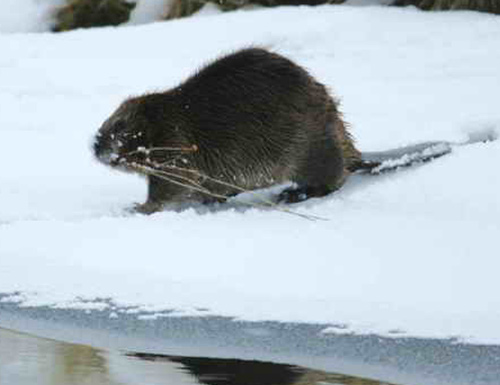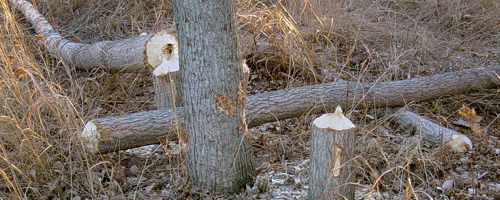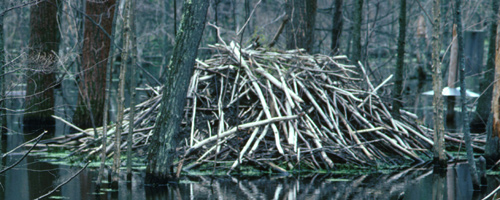American Beavers are thriving in Connecticut. After being erradicated in the state by a combination of habitat loss and trapping in the 1800s, reintroduction and conservation have re-established a Connecticut population of many thousands. Beavers have dark brown fur with stocky, muscular bodies. Beavers are rodents and have prominent incisors that are brownish orange. Their hind feet are webbed for swimming and they have a flat hairless tail about 12 to 16 inches long. They weigh between 30 and 65 lbs.
American Beavers range through the US, Alaska and Canada, except for Florida, Nevada and Southern California. These mammals are semi-aquatic and live in rivers, streams, ponds and lakes. They prefer deeper water than muskrats. Beavers are most active at dawn or dusk. In the fall their activty increases as they prepare for winter and they may be busy around the clock. Beavers are active year-round but mostly stay under water or inside their large lodges in the winter feeding on stored food.
Typical diet in the wild consists of woody plants. Beavers eat the inner bark, twigs, leaves shoots and roots. Beaver do build up extra fat to survive the winter but they store a winter food pile as well. This pile of branches and sticks is piled near their lodge so it can be accessed underwater. Beavers can easily feed when their pond is iced over this way. It is a winter disaster for a Beaver colony if the water level is too low and ice seals them into their lodge. It can result in starvation.
Beavers mate in late January to March, and produce a litter in May or early June. Mated beavers form a permanent, monogamous relationship, although the survivor will take another mate if one dies.
Beavers create their own ideal habitat by building dams of sticks and mud in flowing water to create quiet, deep ponds. Dens may be dug in the banks for use while a lodge is being constructed, but the main Beaver home is their large, distinctive lodge which is built in the beaver pond. Lodges look like very large, domed piles of sticks that rise up out of the water. Entrances and exits to the lodge are underwater, but the living chambers are built above the waterline.
Beavers gnaw down trees using their large incisors and trim off large and small branches for use as construction material and food. Partially gnawed tree-trunks in beaver territory will often have an hour-glass shape. Beavers groom an oil into their fur to keep their coat waterproof and their skin dry underwater. While a beaver swims underwater a clear third eyelid covers its eyes and valves close to keep water out of its ears and nose. The beaver's lips are behind its large incisors. The lips seal off the mouth so the beaver can gnaw away without any water or wood bits going down its throat. While swimming, a beaver's non-webbed forepaws are held as fists against its chest. A beaver can stay underwater for up to 15 minutes. The large flat tail acts as a rudder, is a place where fat is stored, and is also slapped against the water as a warning or alarm in response to intruders. Beavers are very territorial in regards to other beaver colonies.
Neat Fact
Beavers have been observed sharing their lodge with common muskrats in the winter. Muskrats are also semi-aquatic mammals that are smaller than Beavers. Muskrats have been seen using the beaver food cache (and possibly adding to it) and moving among the Beavers inside the lodge chambers by observers using cameras placed in the lodge.


